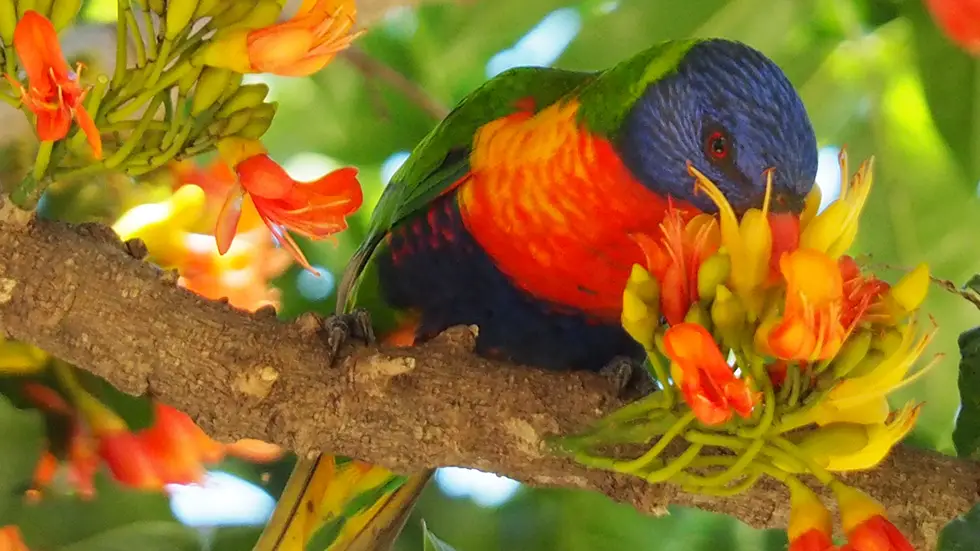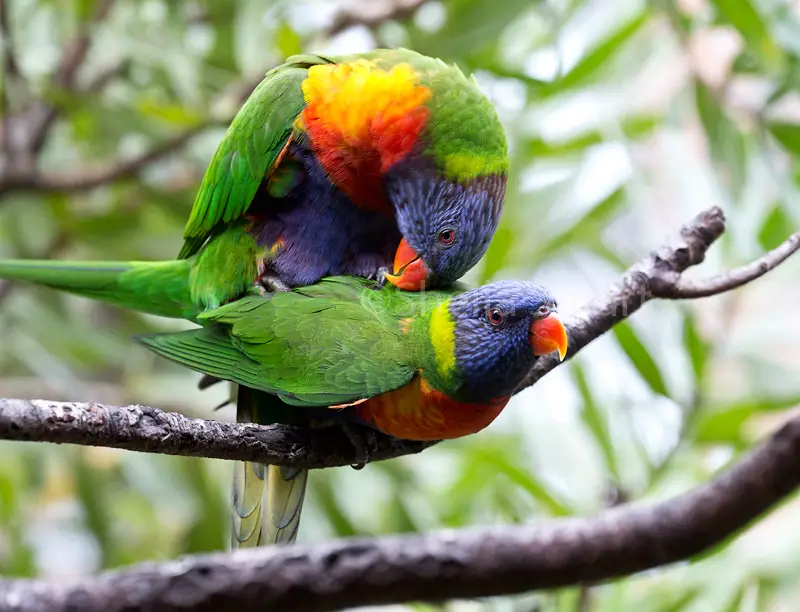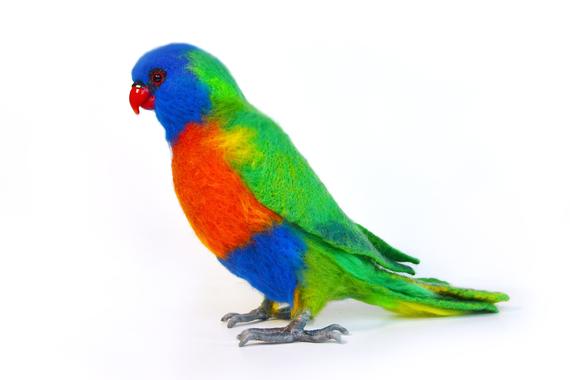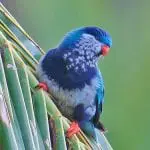Scientific Facts
| Common Name: | Rainbow Lorikeet |
| Scientific Name: | Trichoglossus moluccanus |
| Life Span: | 30 years in captivity |
| Size: | 15 inches |
| Habitat: | Woodland and Rainforests |
| Country of Origin: | Indonesia and Australia |
Overview
Rainbow lorry or rainbow lorikeet has 22 subspecies is one of the most beautiful bird pets available. It needs more time and attention because they need a specific diet as well as housing. If given all the needs, this bird is worth all the owner’s expense and time.
Physical Description
Rainbow lorikeets have a deep blue plumage on their faces and bellies having all the rainbow colors. Their wings, heads, and backs are green, while their breasts are bright red having highlights of orange and yellow on their sides. The skin on their feet is grayish-black. Facial feathers are blue, and beaks are red. their tails are greenish-yellow while the beak is red having a yellow tip. Both sexes of these birds look similar.
Native Region / Natural Habitat
Rainbow lories are native to eastern Indonesia and Australia. They inhabit a vast range of woodlands and rainforest and well-treed of the urban areas. They come in large flocks, and at night, they roost in the trees in hundreds and thousands as well. They are sexually mature at 2 years and rear 2 babies for each clutch.
Size, Weight, and Lifespan
They grow for 15 inches or 30 centimeters on average from their beaks going to the tail feather ends. They weigh 133 grams. In captivity, they live for 30 years. The females are smaller and have shorter bills. Young ones have duller plumage and shorter wings, body, and bills.
Distribution
In northern Australia from Kimberley region until Cape York. In eastern Australia along the east coast and to the Eyre Peninsula in South Australia. They also occur Indonesia region and Papua New Guinea, New Caledonia, Solomon Islands, and Vanuatu.
Temperament
These birds are not shy. They are affectionate, sweet, and comic. In addition, they are enthusiastic and bubbly. They are lively and busy, needing some time to rest. They are entertaining. Playtime for lory is needed. They go out of their cage to spend time with their owners.
Indulging them is necessary for them. Leaving this bird too much causes disorder in their behavior and could ignite self-mutilate. The new owner should be watchful once these birds are not in their face. Rainbow lorikeets could be destructive and mischievous and could be in trouble fast. They get nippy because they are intelligent and excitable. They should be fed by hand to be trained to human touch. Wild species of this bird are sociable and friendly to people.
The feeding flocks consist of 50 to 1000. They travel for 30 kilometers as they are strong fliers. Traveling happens during feeding and roosting sites. they don’t come down to the ground much often unless they are habituated for supplementary food after they get tamed. When breeding season is done, they are seen on isolated trees.
Speech & Sound
They are noisy as they have a high-pitched voice and bark that is squeaky and squawky. Like other lories, they are amazing talkers, for they can learn lots of phrases and words.
Diet

These birds depend so much on the nectar, seeds, pollen, and blossoms from the flowering eucalyptus. Rainbow lorikeets get the nectar inside the flower using their tongue having a hairy brush. In captivity, they are fed on a homemade or commercial mix of nectar. To supplement their diet, green veggies, oats, organic flowers, and fruits are needed.
They are unable to crush the seeds given to them because of their gizzard. Some tend to crack seeds, but the fruit is their main diet. this type of diet leads to loose droppings.
Feeding Methods
Rainbow lorikeets have methods in eating nectars, fruits, or seeds.
• They do nectar extraction using their brush-tipped tongue after they crush the flower using their bill. Papillae are extended while eating to soak the nectars up and gather pollens. Open bills in sideways are brushed up and down.
• Put the open bill over the blossom and project the tongue in the receptacles to take the nectar. Then they comb the bill across a stamen to gather the pollens.
• Inside the open bill, they grate the fruits of rainforest trees.
• The fleshy and sweet fruits are taken from the seed by rolling using their tongue against the plate found in the upper mandible.
• Green eucalyptus flower and leaf buds are chewed.
Care
They bathe often so having a shower perch or bath and a mister in the cage is necessary. They sleep on their backs upside down, which rattles their guardian’s nerves. They are not just bright physically but also intellectually. They can learn tricks as well as other behaviors. Since they are intelligent, they can escape, so door locks should be put.
They love toys that are rattling and jingling. Rotating toys weekly is necessary to not make them bored. Provide lots of toys that are safe from catching your pet’s beak or toe. There should not be strings or other objects to cause injury to the lorry. First-time owners may have difficulty and need more experience to raise this lory.
Take note that most lories don’t deal well with other species of birds because they are so territorial, so don’t leave them alone with the other birds as they could harm or kill other birds.
Breeding

They start breeding in spring. That is from June to January. They nest in the holes of dead or living trees or decayed and chewed wood Breeding is in pairs. Both mates prepare the nest. Their paring is long term. Incubation is done by the female birds, but the males visit and roost in their nest.
Both mother and father bird feed the nestlings and chicks as well. The clutch has 2 eggs and goes for incubation for 22 or 25 days; the fledgling is 56 to 64 days. They are fed for over 2 weeks. This species is prolific in terms of breeding, and they can rear for 3 broods for a season and breed at 12 to 15 months old.
Reproduction
They mate for their whole life. The pairs nibble and preen each other. The resting pairs show minor aggression to the non-paired by protesting and biting. The nest is a hollow limb or just a hole in a tree that is 25 centimeters above the ground, having layers of wood dust put at the bottom. Nesting continues for 8 months. They don’t nest in the rainforest but in the open country instead. Eggs are over 2 oval and white eggs.
Exercise
To maintain this bird’s active lifestyle, they need exercise. Thus, having a large cage with rooms to fly and climb should be given. Give 3 to 4 hours of outdoor play is vital for their emotional and physical health.
As Pets
To a committed owner, this parrot is an excellent one, especially if enough care and time are given. If you intend to adopt this bird, it is like you commit for 20 years of everyday interaction. Again, this bird is affectionate and funny.
Making their mind and beak busy is done by giving them lots of toys. Toys made from wood can help them exercise their beaks as they are avid chewers. Having a diet based on liquid diet results in wet droppings, find a spot to put the cage. An area not having carpet or walls and floors which can be easily cleaned should be considered. You can line plastic sheets for protecting your walls. If you can train your pet to do potty training, then it would be better.
Ecological and Economic Impacts
There are pieces of effort exerted to remove threats to horticulture as well as reducing the risk of diseases among parrots.
Seasonality
Rainbow lorikeets are so sedentary having nomadic movements as a response to plant’s flowering or fruiting seasonally.
Communication
Rainbow lories do frequent chattering and screeching.
Conservation Status
This species has taken positive results from the artificial feeding stations as well as the prolific-fruiting of flowering trees. They have acclimatized to urbanization well and seen suburbs which are well-treed.
Availability: Where to Get One?
Get your rainbow lory in pet stores, bird breeders, avian specialty stores, or from avian-rescue organizations for adoption.
How to Care
To take care of your rainbow lory, below are the things you should do to meet your pet’s requirements.
• Housing: The enclosure should drain on the floor, or the suspended cage is over a concrete or tile floor.
• Diet: Feed with commercial type nectar or a mixture of baby cereal and honey having malt or molasses mixed with clean water. this mix should be made once or two times a day, consisting of 40% of their diet. veggies and fruits, as well as spray millet and sunflower seeds soaked in water.
• Enrichment: They are fond of bathing so much. Toys could be foot toys, swings, noisy toys, puzzles, and so on.
• Nest Box Size: it could be an L-shaped box that measures 51cm x 36cm or 20 x 14 inches.
Interesting Facts
• They are conspicuous, belligerent, noisy, and active.
• They have got a brush-tipped tongue that is for feeding on nectar and pollen.
• They are so gregarious.
• They make use of powder downs. During preening, this powder is spread.
• They bathe by fluttering in foliage that is soaked by rain,
• They bathe by fluttering among foliage soaked by due or rain
• They are fed the whole day.
• They spend 70% of their time eating.
• Their feeding session in the morning continues for 4 hours.
• To meet their daily requirements, they need to eat 2 to 5 hours.
• The feeding rate is 30 to 40 eucalyptus flowers every minute.
• Their feeding bouts are disrupted by 10 seconds of short breaks looking around.
• They have a preference for eating flowers outside tree foliage.
• On hot days, they have a break on midday and go back to the feeding area after.
• They journey to their feeding site of 30 miles.
• They drink water from leaves or fronds.
• A proper toe arrangement and usage of the bill will make them excellent feeders.
Flight
They fly fast using rapid wingbeats. In long travel distances, they fly high, but during short flights, they maneuver between the trees. They establish their flight paths from their roosting sites. These paths follow geographic features similar to coastline or river, valley, or hill lines. Their daily journey is going to their feeding site or 30 miles. It takes 2 to 4 kilometers wide to establish a flight path going to and from the roost.
Flocking
At daytime, they maneuver in smaller groups. Overnight, they fly in thousands of birds. In the morning, groups having less than 10 birds leave their roost. During the whole day, 16 members travel in flocks. 20 birds consist of the feeding flocks.
Predators
Rainbow lorikeets are predated and threatened by the following:
- Raptors including the peregrine falcon, whistling kite and brown falcon
- Diamond python
- Relationship with other birds
- They are frequently with Scaly-breasted Lorikeets.
- They tend to flock with Musk or Little Lorikeets.
- They compete successfully against Indian Mynas and Starlings for hollow nesting.
- They chase bigger birds like Scaly-breasted Lorikeets or Noisy Friarbirds.
Roosting
The size of their roost varies based on the season, but it can be 50,000 birds. During winter and autumn, they non-breeding birds make use of the communal roost when a breeding bird roosts in the nest hollows. They also go down to the feeding grounds found at the radius’ root. They fly in semi-darkness. Before the sunset, they go back to their communal roost. The day roost consists of 10 to 100 birds. In warm weather, they preen or strip twigs and leaves on branches. They search for new food sources during their flight.
Vocal Repertoire
Fledgling has wheeze, which is high-pitched. A protest is made when there is a disturbance at the nesting sites or feeding done on low shrubs. It is accompanied by flapping their wings and head movement sideways. Warble is made by a pair when talking to each other when they are fed, having some rest, or preening. Scouting occurs in flight when they find food or other birds.
FAQ Section
Can you make a rainbow lorikeet as your pet?
Yes. They actually make excellent pets. Just make sure to devote time because you need to keep their beaks and minds busy.
Are rainbow lorikeets noisy or loud?
Quite. Rainbow lories have very fast wing beats that look like colorful torpedos that cross the sound barrier having their squawks. You’ll know what your lorikeet sounds like if you live with a bottlebrush, eucalyptus tree, or grevillea nearby.
Can rainbow lorikeets eat bananas?
Yes. Also, they can eat other fruits, such as mangoes, stone fruit, citrus, grapes, apple melon, and pawpaw. They also love vegetables but avoid giving salty, fatty, and processed human foods.
Do lorikeets mate for life?
Generally, rainbow lorikeets are monogamous. They remain paired and nest in the same tree for long periods.
Are rainbow lorikeets intelligent?
Yes, rainbow lorikeets are highly intelligent. They’re able to learn tricks but don’t get along with other bird species.



